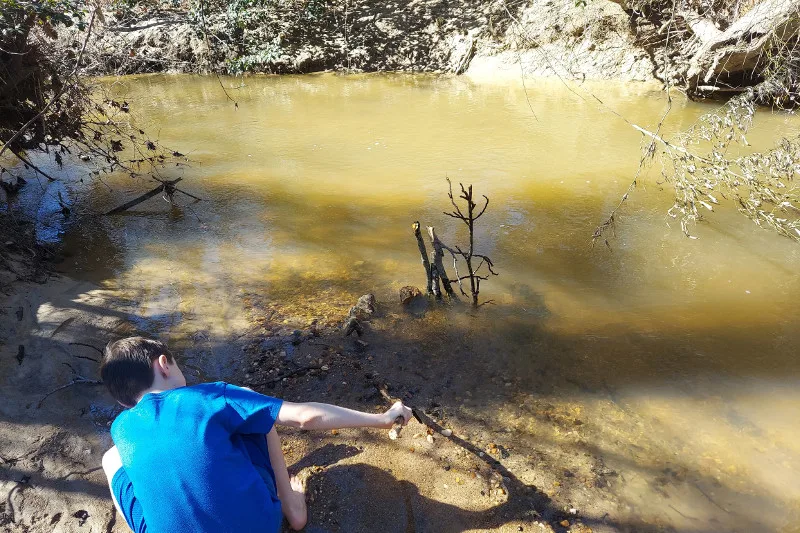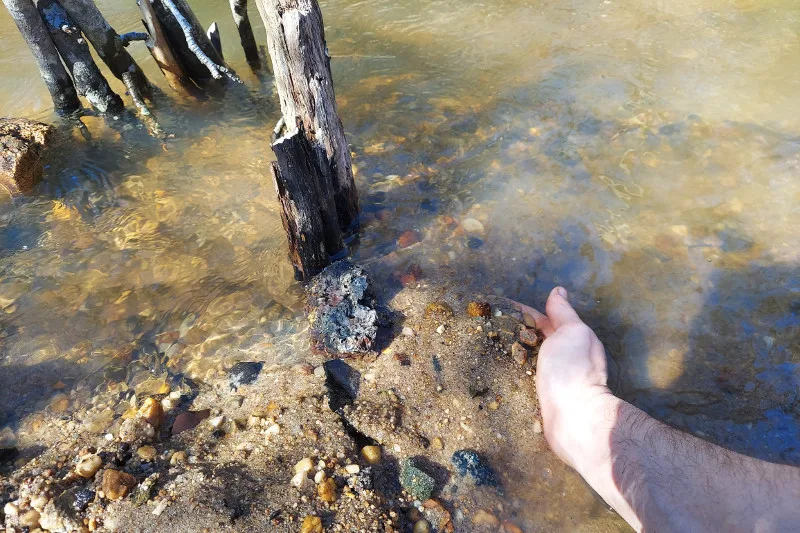SHTFDad may collect a share of sales or other compensation from the links on this page.
Surviving a true wilderness survival situation hinges on your ability to feed yourself. Until you can find your way back to civilization, you will need to help your family stay warm and dry, hydrate, and eat until rescued.
Food runs out quick for the average hiker and then it’s time to turn to forage or hunting game. However, if you build a survival fish trap you will have access to a captive food source.
Fish traps are ancient and have been around for thousands of years. There is a reason every civilization has been started on or around a large body of water. It was about having a water source and a captive food source that could be had through nets or other types of traps.
Our survival fish trap guide is going to introduce you to many effective traps for catching fish in any survival scenario. If there is a body of water that has fish in it, you can build these traps with your kids and give them a try.
Qualities of a Great Trap

The survival fish trap is superior to skills like foraging and hunting for several reasons. Trapping is passive, which means traps can be left and will work on their own.
Fish are a great source of protein, which is hard to come by when foraging. You can focus on other tasks while your trap is catching squirrels, fish, or something else.
A quality survival fish trap is going to be lightweight and easy to carry. If we are talking about a purchased trap then it should be durable enough for multiple uses.
A quality survival fish trap that is made from natural resources should be sturdy enough to get the job done.
Best Primitive Survival Fish Traps
Stone Fishing Weir
The use of stones in this trap sets it apart from most primitive fish traps that use wood. Stones are easy to find and this kind of trap is simple to set up and capture a lot of fish. In a pinch, you can use sticks as well.
There are many different ways you can create a stone or wood fishing weir. Some types will necessitate a large expenditure of energy and time, while others will only require a few sticks and stones to work.
Ultimately, all weir traps use the same general principles of utilizing the current and the environment to trap fish.
Fish Basket
This is the most labor-intensive trap on the list. This is because you will have to weave the basket. The fish basket is kind of a pain to make but it is very effective in a current, once you get it set up. Additionally, once you make your basket, you can continue using it in the future.
The fish basket trap takes advantage of woven sticks into a long basket or cone shape with holes at either end. This is a fantastic project for you and your kids that will teach them critical survival skills, and is just plain fun!
Block off the flow of water in a stream except for a small opening in the middle. The opening should just be smaller than the width of the opening of your basket.
This will hold the basket in place and funnel fish through it. As a result, the only avenue downstream for your future dinner is through the opening and into your basket.
Leave the fish basket trap to do its work while attending to other survival matters. When you return there should be a nice protein-rich meal waiting for you.
L7 Pole Trap
This automatic spring trap is a great primitive trap with an ingenious trigger. This is a fairly simple “set it and forget it” fishing trap. This trap is designed to work without you needing to be there.
The system utilizes a springy sapling that’s cut to the appropriate length and driven into the ground. This is the “fishing pole”.
The sapling fishing pole is tied to the “L” section of the trap, which is in turn notched into the “7”. Finally, the “L” section is also tied to a baited hook that is set into the water.
When the fish takes the bait and pulls on the string, the L7 trap is triggered, the sapling springs back up and the hook is set.
The L7 trigger can be applied to traps in the water and on land. So, the creation of this trap will be a benefit to all of your work.
Trotline
The trotline is a primitive trap though it requires you have some hooks.
Now, any good survivalist or prepper is going to store fishing tackle because of how effective it is. Like we mentioned earlier.
How to Make a Survival Fish Trap
One of the most ancient fishing traps in existence is the fishing weir. So, we are going to build our own fishing weir from the rocks and stones that are available near our little creek.
The fishing weir is ingenious because it takes advantage of the natural current and the innate movements of the fish. They swim with the current into an entrance that has become a natural entry point.
Once they enter this entrance they are both challenged by the current and the design of the entrance. It becomes very hard for them to escape.
Choose A Location
A shallow area that gives way to deeper water is the best place to build the entrance to your stone weir. This is because as the fish swims through the entrance, they immediately drop into the deeper water. As a result, they will have to fight the current and swim to the surface to find their way back out.
In reality, fish will have a hard time escaping this trap.
Gather Materials and Build

Begin by having your kids collect rocks from the creek bank and the local area. These will be the building blocks of your trap. And what young kids don’t love to hunt for rocks! Just don’t let them throw them into the water.
If they can’t find enough rocks you can use sticks that are plunged into the ground close together.
Next, create the entrance of your trap. It should be big enough to allow the size of fish you are after through it. Too small and you will be eating minnows, but protein is protein.

A larger entrance might give you dinner for a few people or a few nights if you are lucky! But don’t make it so large that the fish can make an easy escape.

After you have created the entrance, simply continue adding rocks or sticks to create the walls that will trap the fish.

At this point, add some balled-up bread or other simple kinds of bait to your trap. After your weir has been laid out it becomes a waiting game.
The weir often produces the best results overnight. Alternatively, if you get it set up early in the day you could have some food waiting for you by the time the sun goes down.
Other Tools for Trapping
There are a collection of tools that you can add to a simple trapping kit. These tools will make building and setting traps much easier.
Short-Handed Trowel
This little shovel is the perfect tool for digging holes for in-ground traps. It is also great for building small berms to manipulated prey into an area that is set with traps.
Handheld Wire Cutters
When you are dealing with different kinds of wire or snaring type traps it always helps to have a good pair of handheld wire cutters.
Snare Wire
While primitive traps are very effective, a little snare wire can make the trap more successful and can decrease set up time, too!
Cordage
Spring pole traps often require some kind of cordage to set. This could be paracord, paracord innards, or a simple bank line. Cordage makes setting traps much easier.
Carving or Survival Knife
A full tang fixed blade knife is always going to be a great ally on your quest to trap food. The cutting of wood and the carving of triggers are always made easier when using a good bushcraft knife.
Gloves
You may want to be a primitive trapper on the weekends but if you punch keys during the week your hands are probably soft and cut easily. They will bleed, get raw, and get stabbed by splinters if you are not careful. A good pair of gloves will assure you have much more success and fewer wounds.
Waterproof Boots
Trapping might take you into high places and low-lying areas. If you set up our recommended fish weir then you are going to need to get into the water. Having a good pair of waterproof boots will keep your feet dry out on the trap line.
Conclusion
Survival fishing traps are a great survival skill that we can pass down to our children at a young age. And it’s a fun activity for you and the kids! When you introduce your children to fish traps, nets, and gigs, you are literally teaching them to feed themselves.
These traps are all easy to make. And even if you stumble in the beginning and fail to catch a fish, your kids will never forget sitting on the creek bank with their Dad, working with their hands to create their very own fish trap.

Resources:
